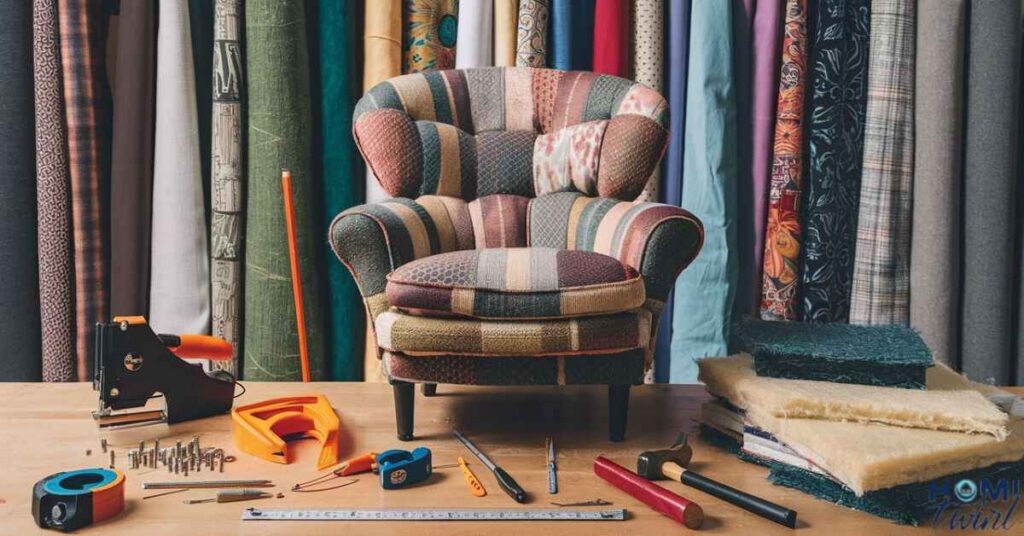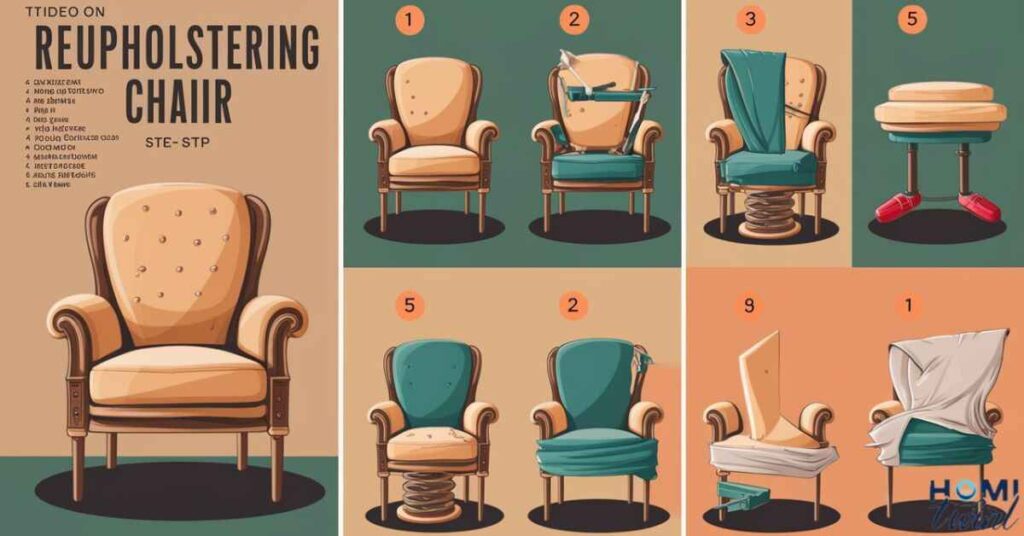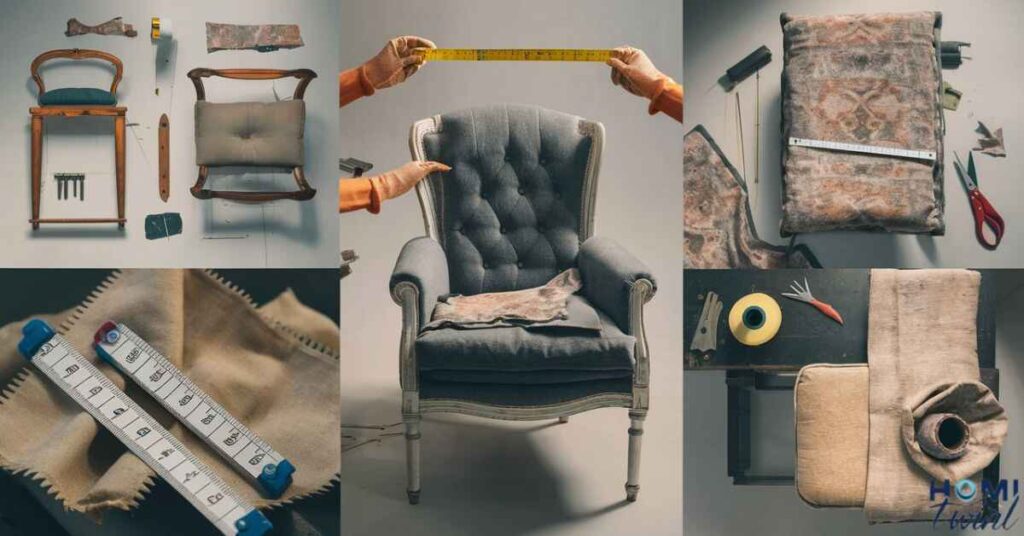When you’re planning to reupholster a chair, figuring out how much fabric you need is key. First, measure the chair’s size – width, height, and depth – including any extra parts like arms or cushions.
Then, calculate the surface area of each part to cover. If you’re using patterned fabric, consider pattern matching and add a bit extra for mistakes and future repairs.
Consulting a fabric chart or a professional upholsterer can help ensure you get the right amount of fabric for the job.
Can I reupholster a chair myself?

Yes, you can reupholster a chair yourself, but it requires some skills, patience, and the right tools. Here are the basic steps involved.
Read This Blog; WHO PAYS THE MORTGAGE ON A HOUSE IN A TRUST
- Assessment: Examine the chair to determine if it’s a good candidate for reupholstering. Ensure the frame is sturdy and the padding is in decent condition.
- Strip the Chair: Remove the existing fabric, carefully documenting or labeling pieces if needed.
- Repair and Prep: Fix any damage to the frame, replace padding or webbing if necessary, and sand or paint the frame if desired.
- Cut New Fabric: Use the old fabric pieces as templates or measure and cut new fabric according to your chair’s dimensions.
- Attach Fabric: Start with the seat and work your way up, stretching and securing the fabric tightly, using staples, tacks, or upholstery glue.
- Finish Details: Trim excess fabric, add any decorative elements like piping or buttons, and reattach any hardware.
- Reassemble: Put the chair back together, making sure all parts fit securely.
While it’s possible to reupholster a chair yourself, it can be challenging, especially for complex designs or if you’re inexperienced. Consider starting with a simple chair or ottoman and be prepared to invest time and effort into the project. Watching tutorials, reading guides, and seeking advice from experienced upholsterers can also be helpful.
What is the easiest way to reupholster a chair?
The easiest way to reupholster a chair typically involves a simple design and straightforward upholstery process. Here’s a basic outline.
- Choose a Simple Chair: Start with a chair that has a basic shape and minimal upholstery details. Avoid chairs with complex designs, intricate curves, or lots of padding.
- Gather Materials: Collect all the necessary materials, including fabric, upholstery tools (staple gun, fabric scissors, pliers), and any additional supplies like batting or foam if needed.
- Strip the Chair: Carefully remove the existing fabric and padding from the chair, taking note of how it was assembled and any areas that may need repair or reinforcement.
- Assess and Repair: Inspect the chair frame for any damage or weak spots. Repair or reinforce as necessary before proceeding with the upholstery.
- Cut and Attach New Fabric: Use the old fabric pieces as templates or measure and cut new fabric according to the chair’s dimensions. Start with the seat and work your way up, securing the fabric tightly with a staple gun or upholstery tacks.
- Finish Details: Trim any excess fabric, fold and staple or tack fabric neatly around edges, and add any decorative elements like piping or buttons if desired.
- Reassemble: Once the upholstery is complete, reattach any hardware or parts removed during the stripping process and ensure everything is securely in place.
By following these steps and choosing a simple chair design, you can make the reupholstering process more manageable, even if you’re a beginner. Remember to take your time, be patient, and don’t hesitate to seek guidance or assistance if needed.
Also Read This Blog: HOW MUCH DOES IT COST TO CLEAN A HOUSE
Can you reupholster over existing fabric?

Yes, you can reupholster over existing fabric in certain circumstances, but it’s generally not recommended for the best results. Here are some considerations.
- Condition of Existing Fabric: If the existing fabric is in good condition, clean, and doesn’t have a lot of wear and tear, you may be able to upholster over it. However, if it’s damaged, stained, or heavily worn, it’s better to remove it and start with a clean slate.
- Thickness and Texture: Adding new fabric over existing upholstery can increase the thickness of the padding and affect the chair’s fit and appearance. Ensure that the additional layers won’t compromise the chair’s comfort or aesthetics.
- Aesthetics and Smoothness: Upholstering over existing fabric can sometimes result in wrinkles, bumps, or unevenness, especially if the old fabric is textured or has seams. Removing the old fabric allows you to create a smoother, more professional-looking finish.
- Odors and Allergens: If the existing fabric has absorbed odors or allergens over time, covering it with new fabric won’t address these issues. Removing the old fabric and properly cleaning or replacing the padding can help eliminate any lingering smells or allergens.
While reupholstering over existing fabric may save time and effort, it’s generally best to remove the old fabric for a cleaner, more professional result. If you’re unsure or inexperienced, consider consulting a professional upholsterer for advice or assistance.
How do I choose a new fabric?
Choosing the right fabric for your reupholstering project is crucial for both aesthetic appeal and practicality. Here are some steps to help you select the perfect fabric.
- Consider Usage: Think about how the chair will be used. Is it a decorative piece that won’t see much use, or is it a heavily used everyday chair? Choose a durable fabric like cotton or polyester for high-traffic areas, and consider more delicate fabrics like silk or velvet for decorative chairs.
- Evaluate Style: Consider the overall style and decor of the room where the chair will be placed. Choose a fabric that complements the existing color scheme, furniture, and decor elements. You can opt for solids, patterns, or textures depending on the desired aesthetic.
- Think About Maintenance: Take into account the fabric’s maintenance requirements. Some fabrics are easier to clean and maintain than others. If the chair will be used frequently or if you have pets or children, choose a fabric that is stain-resistant and easy to clean.
- Feel the Fabric: Visit a fabric store and feel different fabric samples to get a sense of their texture, weight, and drape. Consider how the fabric feels against the skin and whether it provides the desired level of comfort.
- Test the Color: Take fabric samples home and observe them in different lighting conditions to see how they look against other elements in the room. Consider how the color of the fabric will change throughout the day.
- Check Durability: Look for fabrics with a high rub count (Martindale rub test) if the chair will be used frequently. This indicates how durable the fabric is and how well it will withstand abrasion.
- Budget: Determine your budget for fabric and consider the cost per yard. Keep in mind that higher-quality fabrics may be more expensive but can also last longer and provide better overall value.
By considering these factors and taking your time to explore different options, you can choose a new fabric that enhances the beauty and functionality of your reupholstered chair.
What tools and supplies do I need to reupholster a chair?

To reupholster a chair, you’ll need a variety of tools and supplies. Here’s a basic list to get you started.
Tools:
- Staple gun: Used to secure fabric to the chair frame.
- Upholstery needles: For hand stitching and intricate work.
- Fabric scissors: Sharp scissors specifically for cutting fabric.
- Pliers: For removing staples and nails.
- Tack remover: Helps pry out old tacks and staples.
- Hammer: For tapping in nails and securing hardware.
- Sewing machine (optional): If you’re making new cushion covers or need to sew fabric pieces together.
- Hot glue gun (optional): For securing trim and decorative elements.
Supplies:
- Upholstery fabric: Choose a durable fabric that complements your chair and decor.
- Batting or foam padding: Provides cushioning and shape to the chair’s seat and back.
- Upholstery webbing: Supports the seat and back of the chair.
- Tacks or staples: Used to secure fabric and trim to the chair frame.
- Trim: Decorative elements like piping, gimp, or nail head trim to add flair to your chair.
- Thread: Strong, durable thread for sewing and upholstery work.
- Cardboard or chipboard: For creating templates and reinforcing certain parts of the chair.
- Fabric protector (optional): Spray to protect the fabric from stains and spills.
Having the right tools and supplies on hand will make the reupholstering process smoother and more efficient. Additionally, it’s a good idea to have extra fabric and supplies in case you make mistakes or need to redo certain steps.
A tutorial on how to reupholster a chair: A step-by-step guide

Step 1: Gather Your Materials and Tools
Before you begin, make sure you have all the necessary materials and tools.
- Upholstery fabric
- Batting or foam padding
- Upholstery webbing
- Tacks or staples
- Staple gun
- Fabric scissors
- Pliers
- Hammer
- Tack remover
- Sewing machine (optional)
- Hot glue gun (optional)
- Upholstery trim
- Thread
Step 2: Prepare the Chair
Remove the existing fabric, carefully saving any pieces that can be used as templates.
- Inspect the chair frame for damage and make any necessary repairs.
- Clean the frame and remove any old staples or tacks.
Step 3: Cut New Fabric
- Use the old fabric pieces as templates to cut out new fabric for each part of the chair.
- Make sure to leave enough extra fabric for folding and stapling.
Step 4: Add Padding (if needed)
- If the chair requires additional padding, cut and attach batting or foam to the seat, back, and arms using a staple gun.
Step 5: Attach Fabric
- Start with the seat and work your way up, smoothing the fabric and pulling it tight as you go.
- Use a staple gun to secure the fabric to the underside of the chair frame.
- Trim any excess fabric.
Step 6: Finish Edges
- Fold and staple or tack the fabric neatly around the edges of the chair, ensuring a clean finish.
- Use pliers to remove any stray staples or tacks.
Step 7: Add Trim (optional)
- If desired, glue or tack upholstery trim along the edges of the fabric for a decorative touch.
Step 8: Reassemble the Chair
- Once the upholstery is complete, reattach any hardware or parts removed during the stripping process.
- Make sure all parts fit securely and the chair is stable.
Step 9: Enjoy Your Newly Upholstered Chair
- Place your reupholstered chair in its desired location and enjoy your handiwork.
- Remember to take your time and work carefully, especially if you’re new to upholstery. With patience and practice, you can transform an old chair into a beautiful piece of furniture that adds style and comfort to your home.
Frequently Asked Question
Can I reupholster my chair myself?
Yes, you can reupholster a chair yourself with the right tools, materials, and patience. There are many tutorials and guides available to help you through the process.
How much fabric do I need to reupholster a chair?
The amount of fabric depends on the size and style of the chair. Measure the dimensions and consult a fabric chart or professional for guidance.
Can I reupholster over existing fabric?
While it’s possible, it’s generally not recommended for the best results. Removing the old fabric allows for a smoother finish and better adherence of new fabric.
What tools do I need for reupholstering?
Essential tools include a staple gun, fabric scissors, pliers, and a tack remover. Optional tools like a sewing machine and hot glue gun can also be helpful.
How long does it take to reupholster a chair?
The time it takes depends on the complexity of the chair and your experience level. Simple chairs can be completed in a day or two, while more intricate designs may take longer.
What type of fabric should I use?
Choose a durable fabric that suits your style and the chair’s intended use. Consider factors like color, texture, and maintenance requirements.
Do I need to remove the old fabric?
It’s recommended to remove the old fabric to ensure a clean and professional result. However, if the existing fabric is in good condition, you may be able to reupholster over it.
Can I reupholster antique furniture?
Yes, antique furniture can be reupholstered to restore its beauty and functionality. Take care to preserve any original features and consult with professionals if needed.
Conclusion
choosing the right fabric is essential when reupholstering a chair. Consider factors such as durability, style, and maintenance requirements to ensure a successful outcome. Take your time to select a fabric that complements both the chair’s design and the overall décor of the room.
Whether you opt for a classic solid color, a bold pattern, or a luxurious texture, investing in high-quality fabric will enhance the longevity and visual appeal of your reupholstered chair. Remember to measure carefully, gather the necessary tools, and follow step-by-step instructions to achieve professional-looking results. With patience and attention to detail, you can breathe new life into an old chair and create a stunning focal point for your home.







